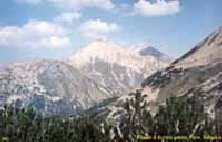|
|
| |
BULGARIA
PIRIN MOUNTAIN
The main ridge of the mountain is aligned from Northwest to South-Southeast. It is about 80 km long and 40 km wide. It covers an area of 2585 km2 of exceptional natural beauty - high peaks, many glacial massifs, 176 lakes. About 90% of these lakes are more than 2100m above sea level. 119 of them were created by glaciers. The most famous of these are: the "Popovo" lake, "Kremenskite" lakes, "Valiavihkite" lakes, "Vlahinskite" lakes, "Bunderishkite" lakes, "Vasilashkite" lakes.
 The sharply contoured landscape and the blend of Central European and Mediterranean climates ensure a wide variety of flora and fauna. In 1962 part of the mountain was proclaimed as a national park, initially named "Vihren" and later on renamed "Pirin". Noting the uniqueness of the park and its global significance, UNESCO included it in the World Register of Natural Heritage.
The park covers an area of 26479.8 hectares and is the largest in the country. It includes parts of the mountain which are above 1000m above sea level with unique ecosystems, areas with specific geomorphology, a large number of Bulgarian and Balkan indemnities and relicts. There are a few trees declared to be natural heritage, including the "Baikusheva" white fir, more than 1200 years old, 16m high and with a circumference of 5.70m.
The park also contains 70 glacial lakes, many caves, waterfalls, majestic abysses and cliffs. The areas of natural beauty include the Bunderishki caves, Kasana, Kioshkata, the rock formation Pirostiata, the Demianishki Skok and Iulenski Skok waterfalls, the natural reserve "Baiuvi dupki - Jinjiritsa".
The mountain is almost impassable. Roads have been made from Bansko, Sandanski, Gotse Delchev.
|
|
|
Festivals and Fairs
The Great Koprivshtitza Folklore Festival
The Great Koprivshtitza Folklore Festival is Bulgaria's largest gathering of traditional musicians and singers and is a cross between a pop festival and a medieval fair. It is a sight that knows no equal: thousands of musicians and singers making the hillside above the picturesque village of Koprivshtitza their home for a few days. Coupled with this you have the colourful stalls of the traders and the thousands of visitors who come for the festival.
This is Bulgarian music as it was always played, played by the ancestors of those who first played it. But perhaps it is what happens on the periphery that is the most authentic. Strolling players or soloists, simply playing for the sheer enjoyment. forming new bonds with other musicians or just letting their music ring out over the hillside.
The Bourgas International Folk Festival
The Bourgas International Folk Festival, held annually, attracts a host of Bulgarian and international artists and is held in the second half of August.
The Kazanluk Festival
The Kazanluk Festival of the Roses is held annually in early June, and has grown from a local to an international event. Not only are the roses, Kazanluk's main industry, in full flower. but the town itself blossoms while visitors enjoy the "Rose Picnic" and all the fun of a folklore festival, with its costumes, songs and dance. Should you still have the energy left, you can always visit the old factories where the rose oil is extracted.
St. Trifon's Day
In the agricultural calendar, St. Trifon's Day celebrates the pruning of the vines, and is held on February 14.
Kukerov Den
On the first Sunday before Lent, Kukerov Den celebrates the start of the agricultural year, and all over Bulgaria you can witness processions led by the dancing. leaping Kukeri dressed in colourful masks and costumes.
Baba Marta
Baba Marta is celebrated on March 1 when peasant house-holds brush out the winter cobwebs with a traditional spring clean. and people offer each other tokens of good luck called martenitsas.
Kukeri
Like western countries. the Bulgarian calendar is dotted with important feast days and festivals. The festival of the Kukeri re-enacts ancient surovaki rites to ward off evil spirits and Kukeri fertility rites. Although only held once every five years, it brings together dancers from all over Bulgaria in a rainbow of colours and styles.
St. Lazarus Day
Lazaruvane is also celebrated in spring on St. Lazarus Day, and here village girls considered fit for marriage perform ritual songs and dances.
St. Konstantin and St. Elena Day
The coming of summer is traditionally celebrated on St. Konstantin and St. Elena Day on May 21, and in some of the remoter villages in the Stranzha hills fire dancing, dancing on heated coals, is still practised in celebration of summer's arrival. Ethnologists have suggested that this practice is directly descended from Dionysina rites of the ancient Thracian.
|